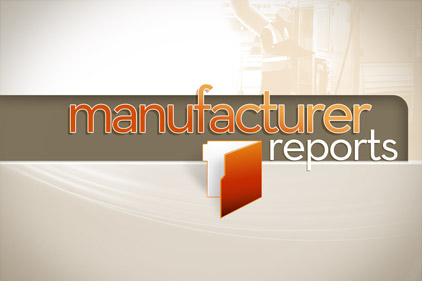“We are pleased and proud that we were one of the first users to switch to the Simatic S7-1200 from Siemens two years ago,” said Joachim Ullmann, head of the electrical department at L+R Kältetechnik GmbH & Co. KG (located in Sundern-Hachen, Germany), and his colleague, programming specialist Olaf Ganser, agreed. This move started a technologically and economically successful change in water recooling systems for the company. And because their experience indicated that the Siemens controllers offered significant advantages, they began installing them in subsequent systems.
About 70 percent of the controllers used in the company’s water recooling systems today are Simatic S7-1200 controllers. The Siemens controller is designed to provide flexible configuration and enable easy and powerful communication by means of its Profinet interface. Ullmann noted, “This modular and cost-efficient Micro PLC covers the requirements for many of our compact water recooling systems and is now fully accepted by all our customers.” One of its major advantages is the fact that up to three communication modules can be connected to the basic device for a total of 16 Ethernet connections, as well as up to eight signal modules for digital and analog inputs and outputs.
This flexibility is extremely important because applications for such water recooling systems are often very different from one another. This also makes for correspondingly simple functionality monitoring of the measuring devices: flow sensors, pressure sensors, temperature sensors, or pH measuring devices, as well as many others, can be easily connected to the controller in this way. Another feature of the controller is that it offers several PID control loops with autotune functionality, which enables simple process applications with closed control loop.
Fast Migration Thanks to User-Friendly Operation
The user-friendliness of the new solution also had a decisive influence on the fast migration to the Micro PLC, as Ganser explained: “Even though the type of programming used here is somewhat different from what we were used to with programmable logic controllers, the advantages provided by the graphical programming used with this controller become clear very quickly.” In fact, he said, the individual function blocks now simply have to be dragged into the program using the “drag-and-drop” feature. The numbers on the keyboard as well as the ‘Enter,’ ‘Back,’ and ‘Esc’ keys are now only needed for parameter settings. “It doesn’t get much easier than that,” said Ullmann.
The uniformity of the command structure allows users to quickly become familiar with the new programming presented by the Simatic S7-1200. As a compact and integrated software solution, the TIA Portal has made getting started with programming and visualization a great deal easier. Ullmann estimated, “Programming with the WinCC Basic HMI engineering tool within the TIA Portal speeds up work by about 30 percent compared to the old platform.”
According to their experiences, both Ullmann and Ganser said that addressing and parameter assignment via Profinet is also noticeably easier than with other systems. Furthermore, the addition of a teleservice adapter based on Ethernet to the S7-1200 is very simple, which is ideal for remote service purposes. Ullmann stated, “Remote service is an important factor in our competitiveness and efficiency, because we offer a ‘24 hour cool line’ (hotline) so that we can provide our customers with round-the-clock support.”
Convenient Visualization Made Easy
The use of the Profinet interface with the water recooling systems also provides additional advantages. The Human Machine Interface (HMI) Key Touch Panel (KTP) provides a touch screen and configurable function keys. This panel allows plant operators to view entire plant flow diagrams, which gives them an overview of all important information at a glance. This includes tank, pump, and cooling generators, as well as important parameters such as temperatures, fill levels, and pressures. Ganser remarked, “With earlier solutions, only simple text displays were economically feasible.”
However, these panels, which are available in four, six, 10, and 15 inch versions, not only provide increased convenience. They are also extremely robust, even in harsh operating environments. There are, for example, water recooling systems that cool rollers in metal foundries, as well as systems that provide cooled water to hot, desert-type emergency showers in nitrogen production. KTP displays are also used with special installation measures in outdoor hydrogen fueling stations in Norway and Finland.
Fast Plant Engineering Right Down to Documentation
The change to the latest Micro PLC technology went very smoothly, as Ganser and Ullmann confirmed. Within just two weeks, all existing function blocks at L+R Kältetechnik were converted to the new graphical programming.
This means that engineering for a new plant, including commissioning and startup check, can take place in about three hours, the two said. A completely new program, including documentation, can now be created in one to two working days. Ullmann said, “The change to this modern control technology was a very smart investment; we were also able to make additional improvements in some places during the migration.”
The controller is available with up to 50 KB RAM as well as up to 2 MB integrated load memory and 2 KB retentive data memory. Because the command structure has been optimized as compared to the previous programming solution, the memory is completely sufficient for these tasks, Ganser and Ullmann said. The work is done with the TIA Portal as starter package including programming and visualization. The first water recooling system with the new controller solution was delivered in February 2010, and the company has had nothing but positive experiences so far.
Manufacturers and operators are not only interested in technical features, but also demand sustainability. These demands are met for both groups by the Simatic S7-1200’s cost-efficient, flexible controller platform. An additional element is the high global availability, which ultimately provides for a long-term, economical overall solution.
Click here for more information on the Siemens Simatic S7-1200 controller.
Publication date: 7/8/2013
Want more HVAC industry news and information? Join The NEWS on Facebook, Twitter, and LinkedIn today!


Report Abusive Comment